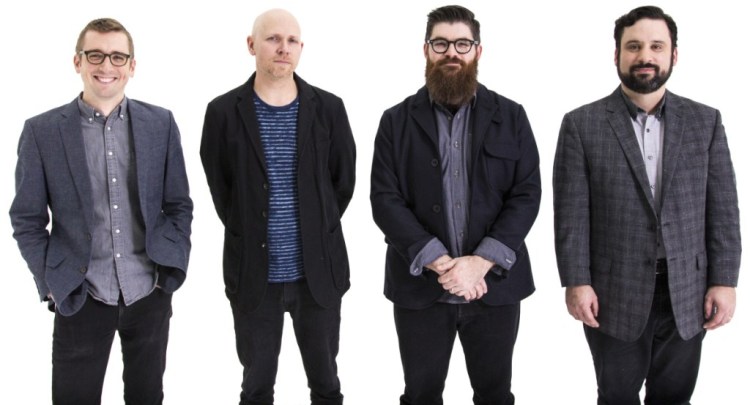BRUNSWICK — If you haven’t heard Sō Percussion – the quartet that closed the Gamper Festival of Contemporary Music (a subdivision of the Bowdoin International Music Festival) on Sunday afternoon at Studzinski Recital Hall – there are three things to know about them.
First, its members are virtuoso players who can extract a musical sound from just about anything, including toys and brake drums, to say nothing of marimbas, trap sets and other more formal parts of the percussion arsenal. Second, Sō specializes in contemporary music – the percussion ensemble being a modern creation – much of it composed specifically for them. And third, their performances, which embrace a measure of choreography, if only as a by-product of the musicians making their way around the array of instruments that fill the stage, have a kinetic quality that’s fun to watch.
For its Sunday program, the Sō players chose three works composed for them in recent years, as well as “Amid the Noise,” a 10-year-old score by one of its members, Jason Treuting, for which they filled out their ranks with a handful of young musicians studying at the festival.
The group’s curtain-raiser was Vijay Iyer’s “Torque,” which begins with the four musicians – Treuting, Eric Cha-Beach, Josh Quillen and Adam Sliwinski – gathered around a marimba, each using a single, small mallet to create a gentle, chordal murmur.
That hazy murmur blossomed into a melody with a chordal backdrop, and from there, the texture grew thicker, louder, faster and more variegated as the players first took up their second mallets, and made their way, individually, to vibraphones and other instruments. At its peak, the work boasted an appealing, interlocking counterpoint, and at times, a humorous, slightly cartoonish underpinning, offered as an understated aside within the tactile swirl of struck timbres.
Carolyn Shaw’s “Taxidermy” begins with the players seated at tables bearing flower pots of different sizes (and, therefore, pitches), exploring the range of sounds that pottery can produce when struck with a soft mallet, tapped with the wooden part of the stick, held in the air, or resting on a surface. The piece was structured almost like a classical rondo, its opening figure returning several times, with expansive episodes (one of which had the ensemble build toward a grand, cadential chord progression) in between.
Donnacha Dennehy – who, at 47, was the oldest composer on the program – contributed “Broken Unison,” the most complex piece on the program’s first half. Using marimbas (sometimes struck, sometimes played with a bow), vibraphones, xylophones and what looked like a brake drum lying on top of a bass drum, the group produced a rich texture of single line themes, punctuated by a recurring chord progression that oscillated attractively between major and minor keys.
The second half of the program was devoted to Treuting’s “Amid the Noise,” a seven-movement piece for which the quartet enlisted a handful of students from the festival to fill out the sound with string, wind, keyboard and extra percussion lines. Electronics, an accordion-like instrument and a trap set, played by the Sō musicians, extended the sonority further. Percussion instruments that had not been used earlier joined the fray as well, among them shakers and a floor tom. And in the finale, the audience was asked to provide a patch of vocal sound by singing a single tone.
Treuting is an inventive composer, and this is his métier, so it was not surprising that “Amid the Noise” was the most wide-ranging and vivid work on an already colorful program. Among its peaks was a movement in which marimbas and vibraphones evoked the rhythmic and melodic characteristics of Asian gamelan music, and another in which Treuting moved to the piano to play a slow, graceful chord progression, offset by light electronic timbres, airy xylophone tracery and some deft inside-the-piano tapping and plucking.
Allan Kozinn is a former music critic and culture writer for The New York Times who lives in Portland. He can be contacted at:
allankozinn@gmail.com
Twitter: kozinn
Copy the Story LinkSend questions/comments to the editors.



Success. Please wait for the page to reload. If the page does not reload within 5 seconds, please refresh the page.
Enter your email and password to access comments.
Hi, to comment on stories you must . This profile is in addition to your subscription and website login.
Already have a commenting profile? .
Invalid username/password.
Please check your email to confirm and complete your registration.
Only subscribers are eligible to post comments. Please subscribe or login first for digital access. Here’s why.
Use the form below to reset your password. When you've submitted your account email, we will send an email with a reset code.